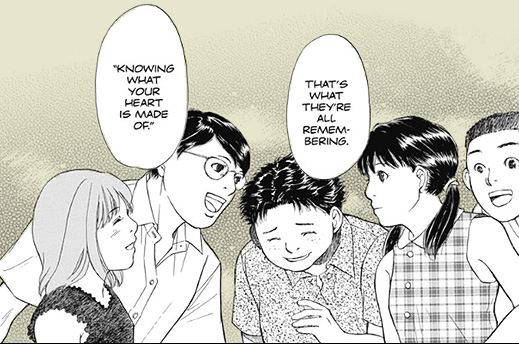Kingyo Used Books
Review of volumes 1–3
I love books and I love reading stories about books. Books are this grave mystery. There is something transcendent about holding another person's brain in your hands, about receiving crystal-clear messages from the dead (if your author is indeed passed on). And books that explore this mystery are a delectable wonder to me.

Half my joy in reading Carlos Ruiz Zafón's Shadow of the Wind (beyond the entrancing period and twisting plot) was the book's love affair with The Book. Not a book but the book—the idea and instantiation of the book. Books. Whatever. Shadow of the Wind is a book that among other things explores the way a book can change your life, the way a book (the right book for you as an individual) can hover over your entire existence, giving it a unique taste and texture.
Kingyo Used Books is interesting because this mysterious power locked up in books (and in Kingyo's case, manga) is the series' central interest. The sad thing is that it only ever broaches lightly the mystery. It's like if you were reading a book about Teddy Roosevelt and that book wanted you to know just how wonderful Roosevelt was, but every time it talked about him, it simply said, "Teddy Roosevelt was wonderful"—or sometimes, "Teddy Roosevelt was marvelous." You could see the author's point, that Sure he thought that Roosevelt was a class act, but you'd never really know why. The same thing is at play in Kingyo.

The series never stops talking about the wonders of manga. All the characters eventually come to agree. We even see that reading the right manga can change lives, inspire confidence, stoke passions, etc. We just never get to see how. Kingyo is thoroughly romantic in its approach to manga as a panacea; I just wish there would be more exploration of why each chapter's manga of choice blooms the changes it does in the affected individual's life. Each chapter of Kingyo features prominently a different manga series, giving readers a potential reading list after they put Kingyo down, but delves little into what makes these individual titles special.
I'm certain Kingyo plays better in Japan, where readers are undoubtedly more familiar with the different books mentioned. I was definitely more invested in chapters that dealt with books I was familiar with (e.g. Tezuka's Adolf and Moebius' Blueberry). In those chapters, just the mention of the books could conjure all that sense of a book's presence that I described as being missing from the series. I had to generate it myself, but perhaps that's what Kingyo's author is planning on. Part of the problem for Western audiences will be the unavailability of so many of the mentioned titles. It would be one thing if there were used manga stores commonly cropping up across the American landscape, but I suspect that I'll never see the majority of books these characters rhapsodize over.

Apart from that substantial disappointment, the stories are all engaging in a kind of breezy way. The central cast isn't so big, consisting of around eight regulars, but each chapter introduces more visitors to the shop (who may or may not recur), such that it's hard to grow that attached to the characters and their unique dilemmas. In some cases, I found the art hindering my ability to discern whether a character was a regular or a new addition. In any case, with so many people flitting through the store and through the narrative, it becomes difficult to draw a bead on exactly what certain characters are like, who they are, how their personalities work. Though I spent three volumes observing the goings-on in the Kingyo used bookstore, I rarely felt I had any better appreciation for who these employees were than I do with the employees of real-life stores or restaurants that I occasionally visit.
Still, the stories are fun and even if I never felt either a connection to the book's characters or any real sense of why the titles featured were worth my time (and maybe being worth my time was never the point), each volume was an enjoyable way to pass an hour. There are little visual treats* as well that work to endear Kingyo's characters, even while they keep themselves at arms distance. The series cheerfully embarks on its single-minded quest to show people getting a lot out of reading—and there's something to be said for that, even when it's not quite as robust a quest as I might prefer.

*note: such as in the first chapter of volume one, when Natsuki wakes at the front desk in the store with Shiba's coat (?) draped over her. It's cute and sweet and never, ever mentioned.
Good Ok Bad features reviews of comics, graphic novels, manga, et cetera using a rare and auspicious three-star rating system. Point systems are notoriously fiddly, so here it's been pared down to three simple possibilities:
3 Stars = Good
2 Stars = Ok
1 Star = Bad
I am Seth T. Hahne and these are my reviews.
Browse Reviews By
Other Features
- Best Books of the Year:
- Top 50 of 2024
- Top 50 of 2023
- Top 100 of 2020-22
- Top 75 of 2019
- Top 50 of 2018
- Top 75 of 2017
- Top 75 of 2016
- Top 75 of 2015
- Top 75 of 2014
- Top 35 of 2013
- Top 25 of 2012
- Top 10 of 2011
- Popular Sections:
- All-Time Top 500
- All the Boardgames I've Played
- All the Anime Series I've Seen
- All the Animated Films I've Seen
- Top 75 by Female Creators
- Kids Recommendations
- What I Read: A Reading Log
- Other Features:
- Bookclub Study Guides











